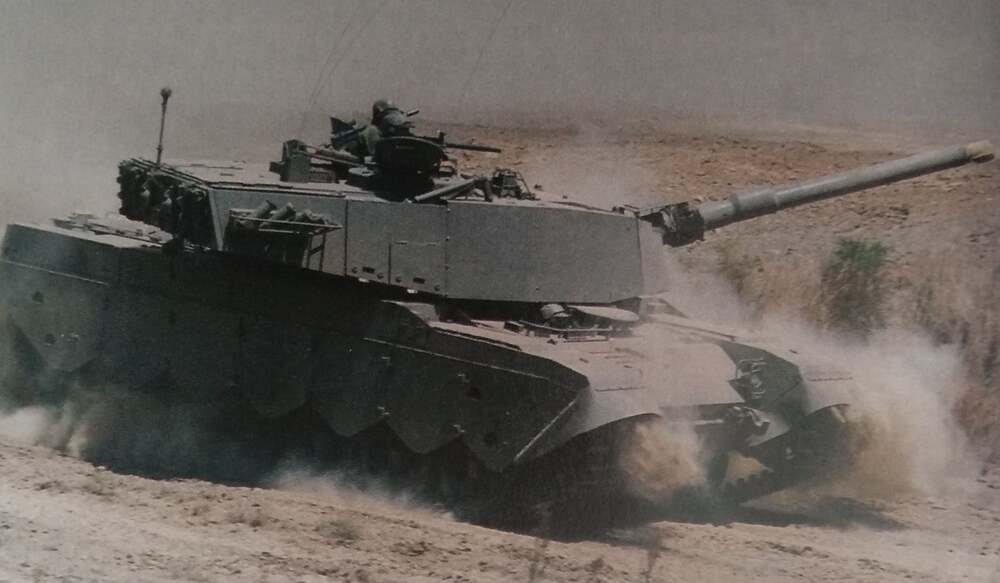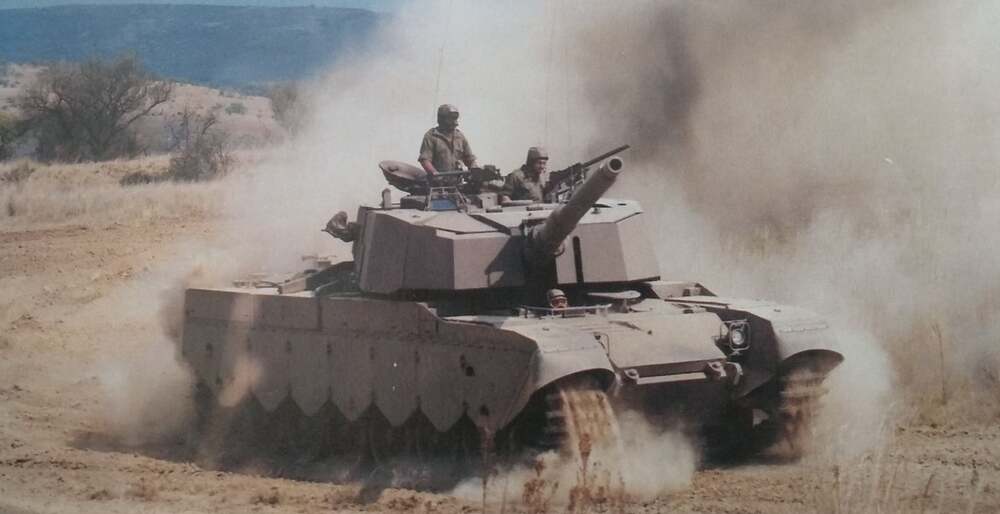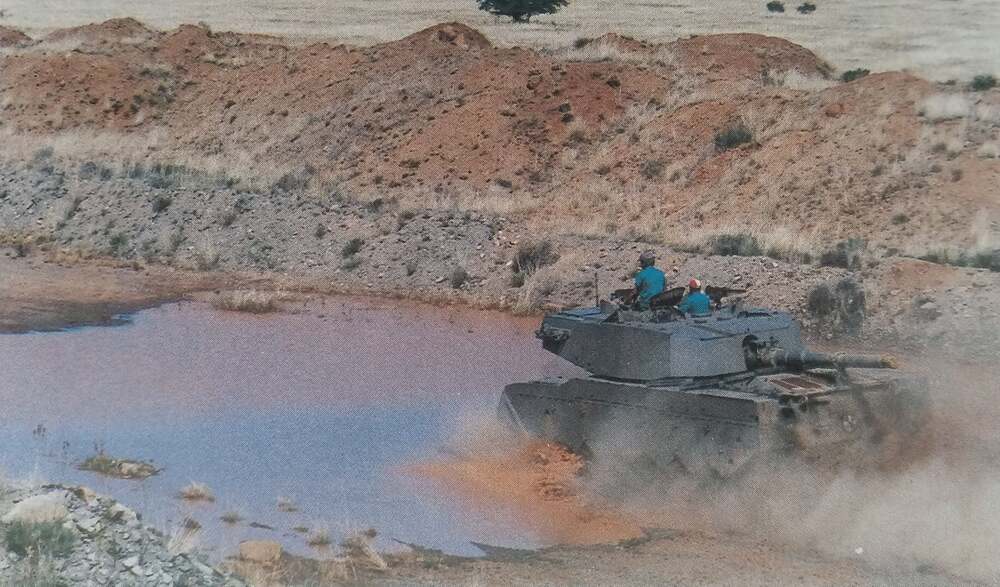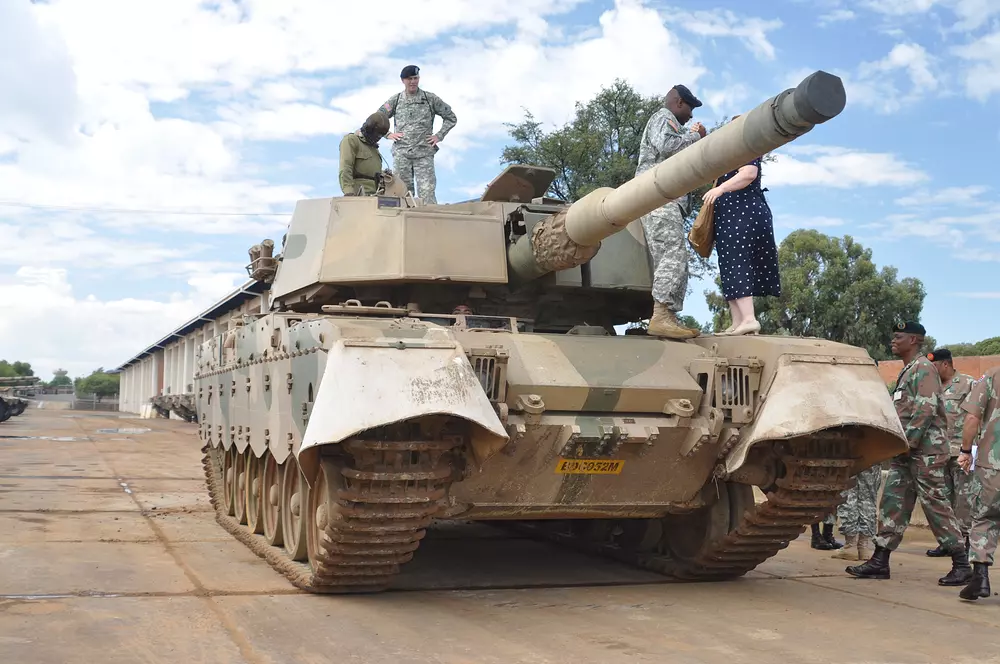- Yes
- No
Welcome to the suggestion post for the Olifant Mk1B! This is one of the Olifant series of tanks, and is the middle child of the two variants we have in-game. In War Thunder, it could provide another addition to the South African sub-tree, adding to lineups, and be one step closer to completing the Olifant series of tanks. This post will heavily rely on the book South African Armoured Vehicles: A History of Innovation and Excellence by Dr. Dewald Venter, a South African author focusing on South African military vehicles, as well as a member of the SA Armour Museum council. Now then, let’s find out some more about this fascinating tank!
History
The Olifant Mk1B has its roots in its direct predecessor, the Olifant Mk1A. Named after the African elephant, the Centurion-derived Olifant Mk1A saw action during the South African Border War, with its first combat debut being during Operation Moduler in late 1987, and January 3rd, 1988 during Operation Hooper. To aid against enemy armor, South Africa had, by this time, acquired the Israeli M111 APFSDS-T round, which could penetrate about 390 mm of RHA at 0°. However, many crews still used HEAT ammunition, which was devastating against lighter vehicles and armor alike. However, while the Olifant Mk1A could deal a punch, it was still vulnerable to the T-54/55s and T-62s it faced, as well as the venerable RPG-7.
An Olifant Mk1A rolling past a FAPLA M-46 130mm field gun in Angola, 1987/88.Realizing that their design would need to be improved, OMC, Olifant Manufacturing Co., had begun development in 1981 of a successor to the Olifant Mk1A soon after it went into production. With the combat debut of the Olifant Mk1A, its shortcomings were quickly exposed, which included poor protection against HEAT ammunition, poor mobility, as well as taxing maintenance requirements. There was also fear that the Soviets would ship T-72Ms to Angola, which would outperform the Olifant Mk1A. As such, the primary focus was put on increasing the tank’s protection, with a secondary focus on mobility and reducing the time required for the vehicle’s maintenance. To do this, the successor, the Olifant Mk1B, would be a complete redesign, as opposed to being another upgraded Centurion.
When the vehicle design was completed, two prototypes were sent for trials at De Brug, Lohatla, and Vastrap in 1986, where for five months they would undergo testing with two Olifant Mk1A crews from E-Squadron. Below is an account from one of these crew’s drivers, who was one of the first to drive the Olifant Mk1B. This account can be found on page 62 of the book listed under sources.
E-Squadron tank crew at Vastrap airfield with an Olifant Mk1B, 1986.On E-Squadron’s return from attachment to 61 Mech in South West Africa at the end of February 1986, two Olifant Mk1A crews were selected and an extra tank driver included in the group along with some Tank transporter drivers, Echelon, medic, mechanics etc and the group was attached to the Armour wing Research and Development unit under Major French and Major Wagenaar.*
We travelled to Pretoria to sign secrecy documents and collected the prototype Olifant Mk1B and a standard Olifant Mk1A from OMC. The idea was to drive both vehicles in the coming months through a series of trails and compare their performance. The program lasted four to five months and included tests at De Brug, Bloemfontein, Army Battle School Lohatla and Vastrap in the Northern Cape. All troops were armed with live ammo for our R5s and both tanks were transported on public roads hidden under cammo net/tarpaulins.
First stop was back in Bloemfontein, we operated from the “Jonker Loods” area of De Brug. Here for example we drove both tanks around the perimeter of the Debrug training area for 24 hours to measure fuel consumption, engine temperatures and compare temperatures of the standard road wheels on the Mk1A with the various synthetic materials on the Mk1B road wheels.
One lap around the training area (21km if I recall correctly) the Mk1A following the Mk1B a few kilometer[s] behind, included driving up over and down the other side of “Stormberg” koppie and seven laps of the tank obstacle course at flat out speed. On one of my laps around the obstacle course I managed to break a suspension unit on the Mk1B and there was at that stage only one spare. Another driver got the Mk1B right track into a trench while turning slightly and driving at a high speed which of course pulled the right side track off…he was not popular with the tiffies!
At the end of the lap we stopped at our base of operations and the OMC guys would check and log everything, the tank would then go off on another lap and then the same would happen when the following tank arrived.
Army Battle School Lohatla we did a lot of shooting, the weapon control system was very accurate and very impressive. During Vastrap we did a lot of driving in the desert. As operational Mk1A crews our loyalty lay with the Mk1A and we drove the guts out of that tank to try to show it was the equal of the new kid on the block Mk1B. Our Mk1A performed very well, was tough and reliable, however at the end of the day there was no doubt at all that the Mk1B outperformed it in every aspect that we were aware of! Mk1B was more comfortable drive, significantly faster, had better ergonomics, vastly improved fire control system etc.
-Trooper (retd) G.G. Swart
In total, 44 Olifant Mk1Bs would be built in two batches of 22 each beginning in 1991. When it entered service, the Olifant Mk1B weighed 3 t more than the Olifant Mk1A, but this was offset by the same Continental V-12 engine being improved, giving it an additional 200 hp, increasing the total hp to 950. This, in turn, increased the horsepower / ton ratio to 16.1 hp/t. Included in the upgrade was a new automatic transmission called AMTRA 3, assembled by Gear Ratio, which when installed in the Olifant Mk1B, provided double-differential steering, two-speed mechanical steering drive and hydraulic retarder. The combination of these two key elements allowed the Olifant Mk1B to accelerate from 0-30 km/h in 11.5 seconds on flat terrain, and achieve a top speed of 58 km/h on road, a vast improvement over its predecessor’s 45 km/h.
Other improvements were made, such as replacing the Centurion Horstmann suspension with a torsion bar suspension with hydraulic dampers, bump stops being fitted to all road wheels, telescopic dampers fitted to the front two and back stations, as well as the replacement of the tillers steering system with a yoke system. These changes made for a smoother and overall less taxing ride for the driver and turret crew.
The new design also had a greater range, carrying 1,382 liters (365 US gallons) of fuel compared to the 1,240 liters (328 US gallons) on the Olifant Mk1A, allowing it to travel 360 km (224 miles) on road, 240km (149 miles) off-road, and 150km (93 miles) on sand. With the new design, the entire power pack could be removed, in part thanks to the extra space provided by the redesigned hull, which had a large engine compartment. To reduce the number of road wheel replacements done, an outer polyurethane surface was applied which increased the road wheel life span from 300 km (186 miles) of the Olifant Mk1A to 1,200km (745 miles) on the Mk1B. With the extended engine compartment which lengthened the overall hull, an additional track link was added which brought the total to 109 track links on each side of the tank. Another logistical change is the addition of two water tanks inside the turret, one left, one right, with a total capacity of 101 liters, or 26.8 US gallons. This reduces the need for the crew to exit the tank to resupply water in the hot conditions the Olifant Mk1B was expected to fight. For the crew’s comfort, more comfortable seats and a fume extractor fan were added, the latter to help clear the turret compartment of excess fumes after the main gun fires.
The main armament itself remained relatively unchanged, with the reliable 105 mm GT3 L/52 semi-automatic gun being retained, produced by LEW. However, added to the gun was a new thermal sleeve and fume extractor, which helped improve accuracy during sustained fire by reducing barrel droop by as much as 70-90%. The Fire Control System on the vehicle was designed by Reutech Systems in 1990 to replace the Olifant Mk1A’s 30 year old system. This new system, called HIFF, featured a ballistic computer, sight drive, and electronics paired to a touch button control system and sensors which accurately measured meteorological conditions which can affect the fire accuracy of the main gun, such as ambient temperature and wind speed, from the environmental sensors. This new system would calculate the gun laying needed for a designated target in less than two seconds, and let the gunner know when the gun was on target and ready to fire by a light. Included for the gunner was an Eloptro 8x day sight with an integrated ballistic computer, co-mounted with a laser rangefinder. Information and data from the rangefinder is fed into the split range drum, which applies elevation to the main gun. Tests with this system revealed that it was accurate within 30cm x 30 cm (11.8 inches x 11.8 inches) at 3km (1.86 miles)!
The Olifant Mk1B’s ammunition suite was improved with the acquisition of new Israeli tank rounds, primarily sabot ammunition, such as the M413, M426, and the Denel M9718 APFSDS-T rounds, all of which featured greater mass and penetration over the older M111 used on the Olifant Mk1A. Olifant Mk1B crews would, however, still keep their favored M456 HEAT-FS ammunition, as well as high explosive and white phosphorus ammunition. About 65 main gun rounds could be carried inside the tank, which are carried in protected stowage bins below the turret ring. The turret bustle was also extended, adding more room for crew equipment, and redistributing weight away from the new solid-state electronic gun control system and turret drive, which allowed the Mk1B to traverse its turret 360° in 16 seconds, 14 seconds lower than that of the Mk.1A. Similar to its predecessor, the Olifant Mk1B carries a single coaxial 7.62 mm Browning MG4 with a 2,000 round ready bin replacing the 200 round boxes used in the Olifant Mk1A. In total, at least 6,000 rounds of 7.62 mm ammunition are carried inside the tank.
OMC managed to achieve their goal of increased protection, which was done by adding passive composite armor packages on the turret and frontal hull glacis, which can be replaced in the field. While at first glance it may appear as a weak point, the gap between the composite armor and hull on the turret front is intentional, to act as spaced armor against HEAT rounds, but this gap can be filled if necessary in the future. Currently, the exact composition of this new armor is classified, but during testing, the T-62’s 115 mm HEAT-FS ammunition could not penetrate the turret. Another weapon OMC had in mind when designing the Olifant Mk1B was the Soviet 23 mm anti-aircraft gun, which took its toll on a number of South African armored vehicles during the Border War. As a result of this, the entire hull of the Olifant Mk1B is protected from 23 mm anti-aircraft fire. However, one major threat encountered, mentioned prior, is the RPG-7. The passive composite armor can negate the effects of the RPG-7 entirely, and the redesigned side skirts can serve the same purpose. For protection against landmines, a double armored floor was added, sandwiched between which is the torsion bar suspension system. As well as this, a new fire suppression system was installed in the crew and engine compartment, and storage bins received lids to reduce the chances of their contents igniting when struck. One problem experienced with the Olifant Mk1A was the smoke grenade banks being damaged when ‘bundu bashing’, and as a result, these were moved to the rear of the turret on the Mk1B. If needed, the engine can produce smoke exhaust by a fuel injection as well. All in all, this new armor weight adds about 3 tons, as mentioned prior.
An Olifant Mk1B on display.Two variants of the Olifant Mk1B are known to exist, the first of which is technically not a variant, the Olifant BLT (Bridge Laying Tank), which makes use of the components and engine of the Mk1B, but is not based on the Mk1B. Two of these types are known to be employed by the SANDF Engineering Corps.
 An Olifant BLT.
An Olifant BLT.
The second vehicle is a more interesting one, the Olifant Mk1B Optimum, a prototype vehicle built by LEW in the late 1990s as a potential way to upgrade the Mk1B fleet. It featured a new ready rack, arrow shaped armor, as well as thermal imaging for the gunner. Testing was done in 2003, but unfortunately for the SANDF, there were limitations to their budget, and as a result, the Olifant Mk2 was born, 26 of which were converted Olifant Mk1Bs, which is a story for another day! Should you like to know more about the Optimum, you can find a suggestion by NaasBotha24 here!
An Olifant Mk1B Optimum, noted for its ‘arrowhead’ turret armor.As mentioned, 26 Olifant Mk1Bs were converted to Mk2s, and the rest currently are in storage at Wallmansthal testing ground. While the Olifant Mk1B was not quite up to the standards of its time, owing to logistical shortcomings, armament, armor protection, power to weight ratio, and more, there is no denying it was a significant improvement over its predecessor, and was an important step up for South Africa.
Dr. Dewald Venter (left) with the Chair of the SA Armour Museum Lt Col R Erasmus, in the background is a South African Olifant Mk.1B.Specifications

Sources
- Venter, Dewald. South African Armoured Vehicles: A History of Innovation and Excellence, Helion & Company, Warwick, 2020, pp. 58–62.
- https://www.army-technology.com/projects/olifant-mk1b-main-battle-tank/










